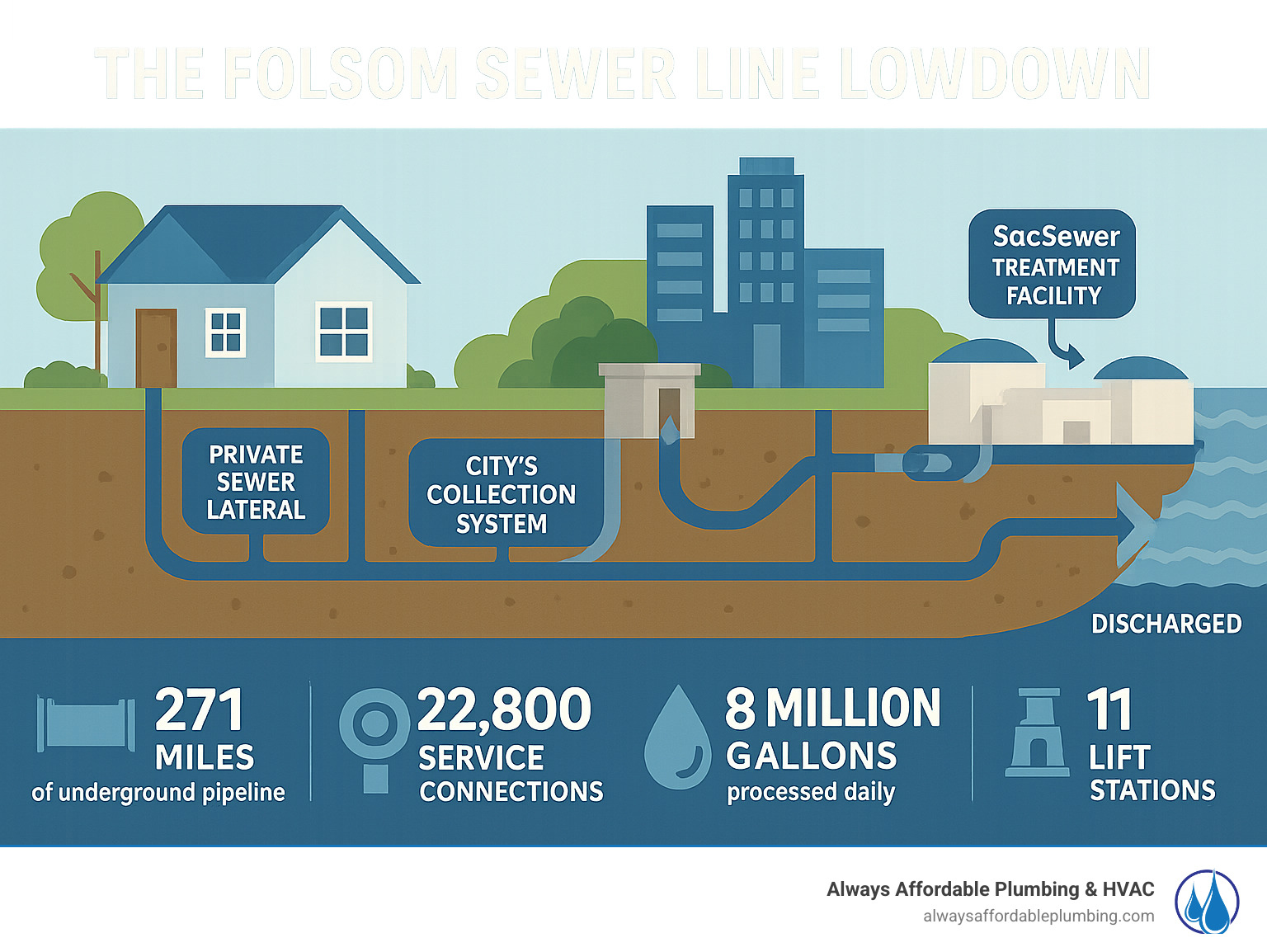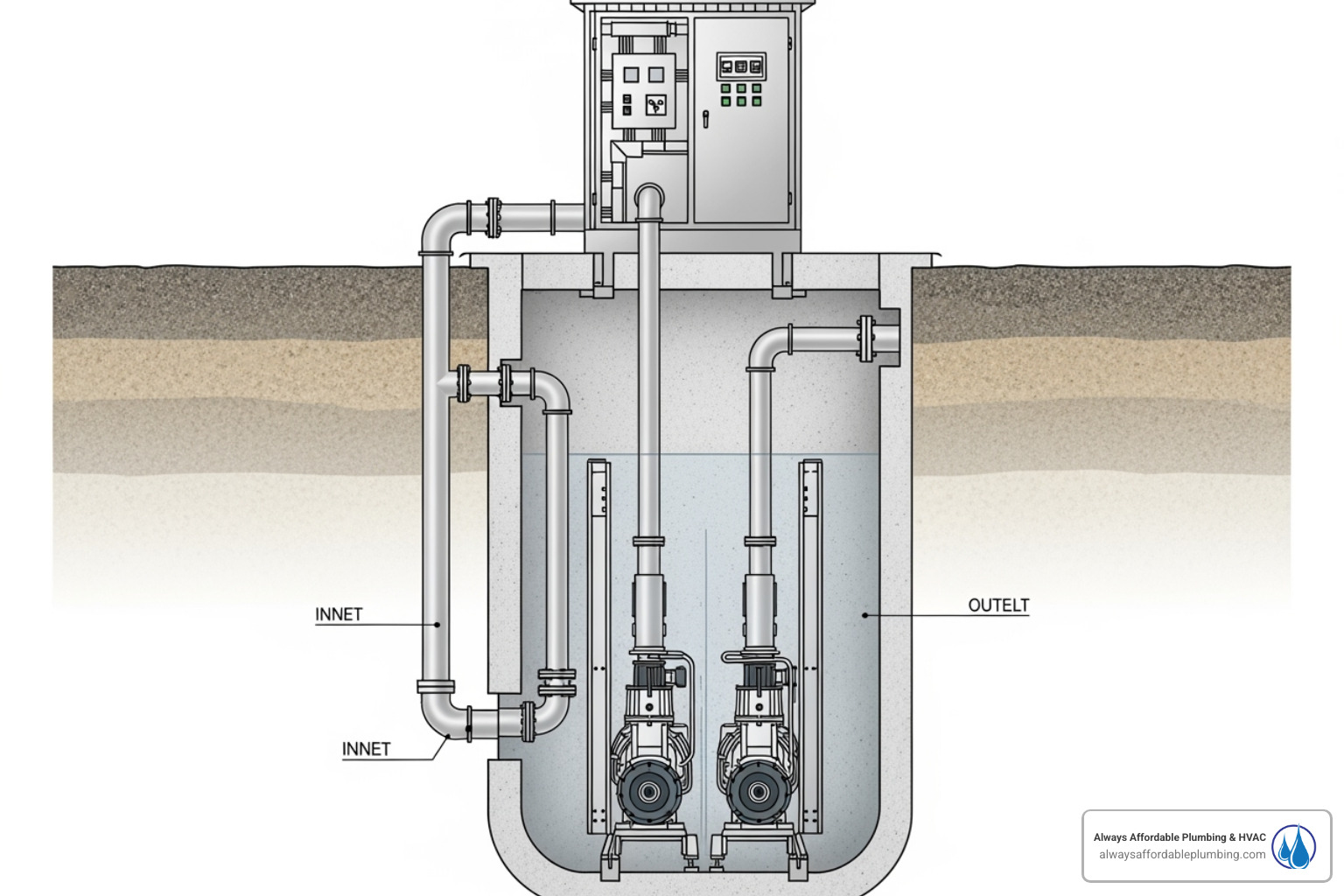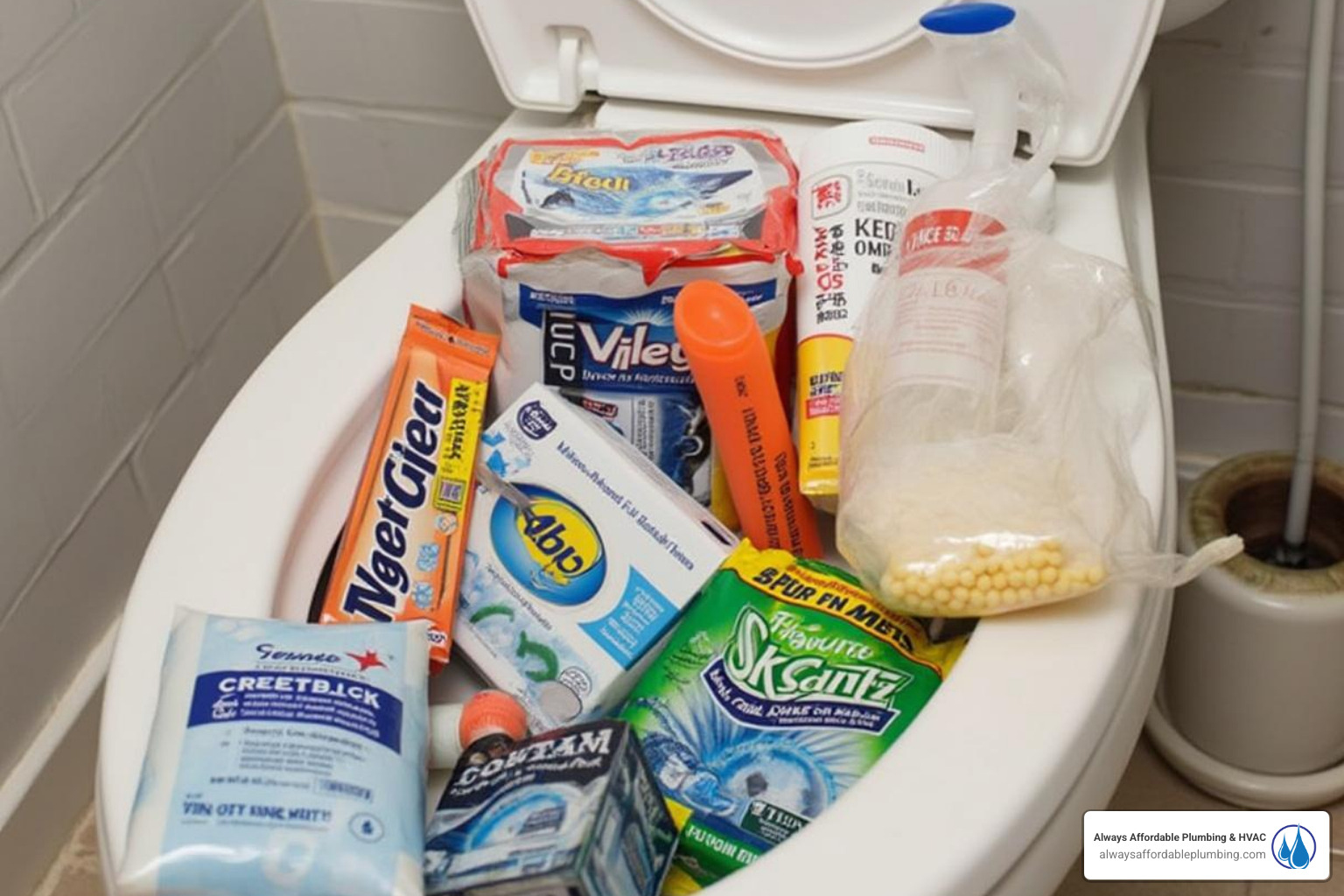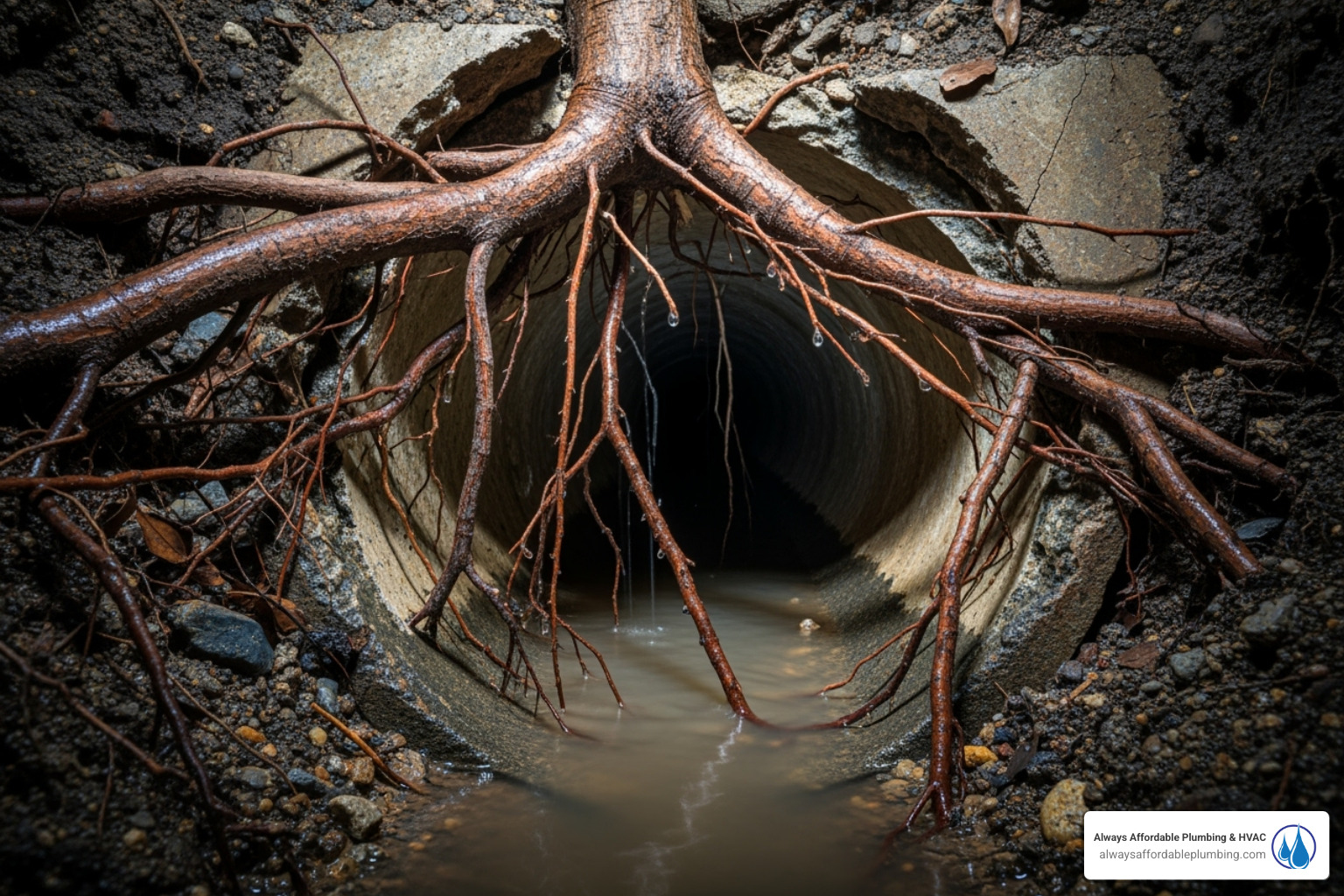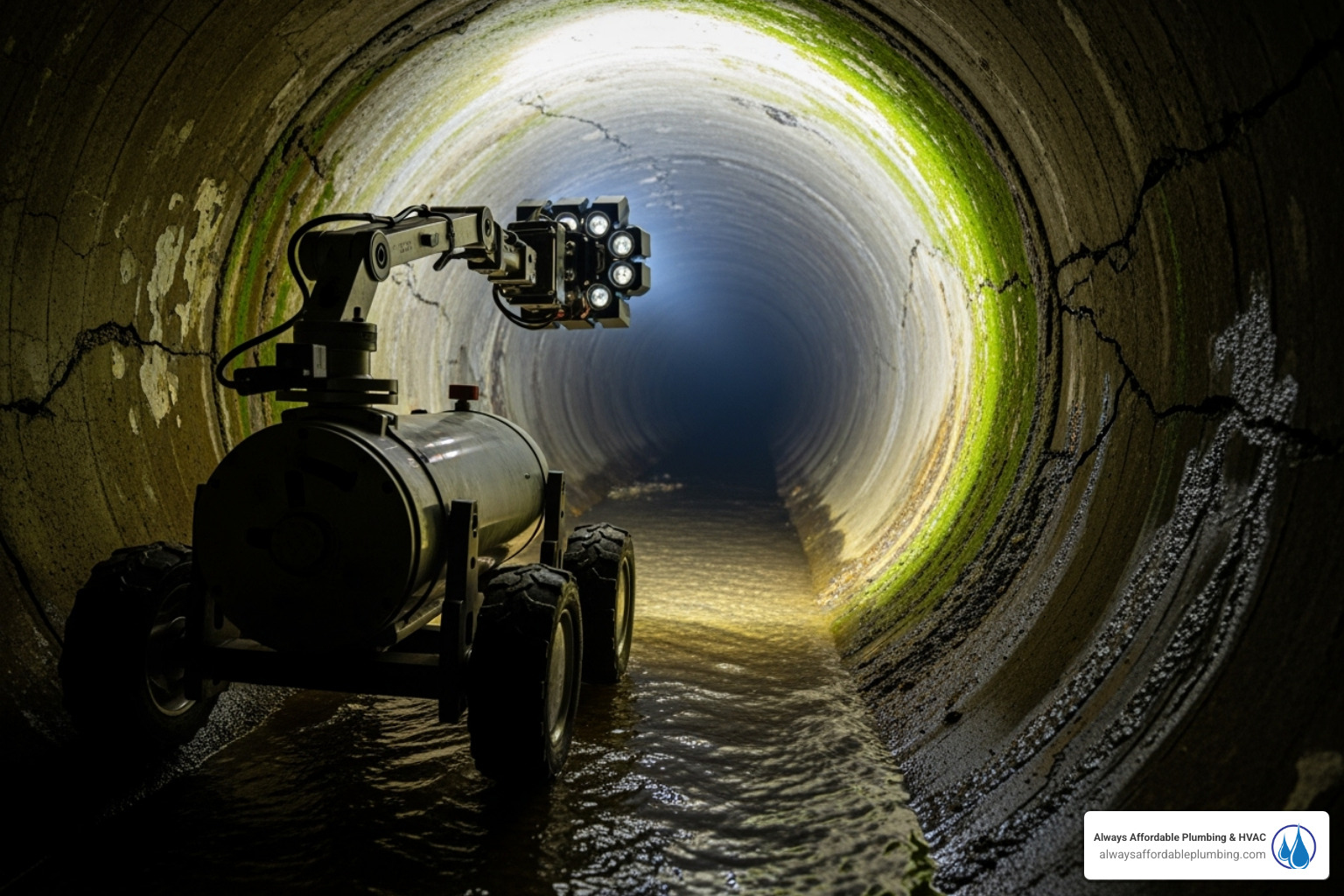
04 Sep The Folsom Sewer Line Lowdown
Understanding Folsom’s Essential Underground Infrastructure
Sewer line Folsom systems form the backbone of our community’s sanitation and public health protection. Here’s what every Folsom homeowner needs to know:
Key Facts About Folsom’s Sewer System:
- 271 miles of underground pipeline throughout the city
- 22,800 service connections serving homes and businesses
- 8 million gallons of wastewater processed daily
- 11 lift stations moving waste to treatment facilities
- Wastewater flows to Sacramento Area Sewer District (SacSewer) for treatment
Most Folsom residents take their sewer system for granted until something goes wrong. But understanding how this massive underground network operates can help you protect your home and avoid costly repairs.
The city’s Wastewater Collection Division maintains the public sewer mains, while homeowners are responsible for their private sewer laterals – the pipes connecting your house to the city system. This shared responsibility means both the city and residents play crucial roles in keeping everything flowing smoothly.
When sewer systems fail, the consequences go far beyond individual inconvenience. Blockages and overflows can threaten public health, contaminate local waterways, and create expensive cleanup situations. That’s why Folsom has implemented a comprehensive Sewer System Management Plan, approved by the City Council and updated regularly to meet state requirements.
Folsom’s Vast Sewer Network: A Look at the Numbers
When you flip a switch, electricity flows. When you turn a faucet, water comes out. And when you flush the toilet or drain the sink, everything disappears down your sewer line Folsom system. But have you ever wondered just how massive this underground network really is?
The numbers might surprise you. Folsom’s sewer system spans an incredible 271 miles of pipeline – that’s roughly the distance from Folsom to San Francisco! All of this infrastructure works silently beneath our streets, sidewalks, and yards, carrying away waste from every corner of our community.
But gravity alone can’t handle everything. That’s where Folsom’s 11 lift stations come into play. Think of these as the unsung heroes of our sewer system – powerful pumping stations that push wastewater uphill when gravity isn’t enough. Without them, waste from lower-lying areas would have nowhere to go.
This vast network serves 22,800 service connections across Folsom – nearly every home and business in our city. Every day, this system quietly handles about 8 million gallons of wastewater. To put that in perspective, that’s enough water to fill about 12 Olympic-sized swimming pools!
So where does all this wastewater end up? It doesn’t just disappear into thin air. Everything flows through Folsom’s collection system to the Sacramento Regional County Sanitation District (SacSewer), where it undergoes advanced treatment before being safely returned to the environment.
SacSewer operates one of the most sophisticated treatment facilities in California, cleaning millions of gallons daily to strict environmental standards. They even produce recycled water that can be reused for irrigation and other purposes – turning waste into a valuable resource.
This partnership between Folsom and SacSewer ensures that our community’s waste is handled responsibly, protecting both public health and our precious local waterways. It’s a remarkable system that most of us never think about, but it’s absolutely essential to our daily lives.
Want to learn more about this fascinating process? You can learn more about the SacSewer treatment process and see how they’re working to protect our environment every single day.
How the City Manages the Sewer Line Folsom System
Running a sewer line Folsom network that spans 271 miles and serves nearly 23,000 connections is like conducting a massive underground orchestra. Every pipe, pump, and connection needs to work in perfect harmony to keep our community healthy and our environment protected.
The city accomplishes this impressive feat through something called a Sewer System Management Plan, or SSMP for short. Think of it as the master playbook for everything sewer-related in Folsom. This comprehensive plan isn’t just bureaucratic paperwork – it’s a living document that guides how our city keeps wastewater flowing safely from your home to the treatment facility.
The State Water Resources Control Board requires every city in California to have an SSMP, and for good reason. The primary goal is reducing sanitary sewer overflows (SSOs) – those unpleasant situations where raw sewage backs up into streets, homes, or waterways. Nobody wants that happening in their neighborhood!
Folsom takes this responsibility seriously. The City Council first approved our SSMP on July 28, 2009, with Resolution No. 8526. But the city didn’t just file it away and forget about it. They’ve consistently updated and re-certified the plan to keep up with changing regulations and improving practices.
The first five-year review happened on August 26, 2014 (Resolution No. 9419), followed by another thorough update on July 23, 2019 (Resolution No. 10312). Most recently, with new state requirements calling for six-year updates, Folsom approved its latest SSMP on July 8, 2025, under Resolution No. 11416. The next update is due by August 2, 2025, and knowing Folsom’s track record, they’ll be ready.
This ongoing commitment means our sewer line Folsom infrastructure isn’t just maintained – it’s continuously improved and adapted for future challenges. If you’re curious about the specific rules governing wastewater in our city, you can view Folsom’s wastewater regulations in the municipal code.
The Folsom Wastewater Preventative Maintenance Program
Here’s where things get really interesting. Instead of waiting for pipes to break or block up, Folsom takes a “fix it before it breaks” approach. Their preventative maintenance program is like getting regular check-ups at the doctor – it catches small problems before they become big, expensive headaches.
Routine cleaning forms the backbone of this program. City crews regularly flush out the sewer mains to remove grease buildup, debris, and other nasty stuff that can cause blockages. The biggest troublemakers? Grease and large debris like rocks and cans that somehow find their way into the system.
But cleaning is just the beginning. The city also uses CCTV video inspections – essentially sending robot cameras through the pipes to get a close-up look at what’s happening down there. These high-tech inspections can spot cracks, tree root intrusion, and structural problems without digging up your street or yard.
The maintenance team doesn’t stop there. They conduct system evaluations using all the data they collect from cleaning and inspections. This helps them spot trends, identify problem areas, and create a smart repair and replacement schedule that prioritizes the most critical needs first.
This proactive approach saves everyone money in the long run and keeps our sewer line Folsom system running smoothly year after year.
Who is the Folsom Wastewater Collection Division?
Meet the unsung heroes of Folsom’s underground world – the Wastewater Collection Division. These dedicated professionals are responsible for keeping all 271 miles of pipeline and eleven lift stations operating smoothly, 24 hours a day, 365 days a year.
Their daily work includes inspecting, cleaning, repairing, and maintaining every component of the wastewater collection system. When something goes wrong – like a backup or overflow – they’re the first responders who spring into action to fix the problem and protect public health.
Think of them as the emergency room doctors for your sewer line Folsom system. They diagnose problems, perform the necessary repairs, and get everything flowing normally again as quickly as possible.
If you’re dealing with sewer problems, strange odors, or any kind of overflow situation, these are the people you want to call. You can reach the Folsom Wastewater Collection Division at 916-461-6177 or email them at [email protected].
Don’t hesitate to contact them if something seems off with your sewer system. Quick reporting helps the city maintain system integrity and prevents small problems from becoming neighborhood disasters.
Your Part in Protecting Folsom’s Sewer System
While the City of Folsom’s Wastewater Collection Division works tirelessly to maintain the public infrastructure, protecting our sewer line Folsom system is truly a team effort. Every homeowner plays a crucial role in keeping this vital network running smoothly, and the good news is that most of what we need to do comes down to simple, everyday habits.
Understanding where your responsibility begins is the first step. The city takes care of the main sewer lines that run beneath streets and public areas, but your private sewer lateral – that’s the pipe connecting your home to the city’s main line – falls squarely on your shoulders. This includes everything from your house to the point where it connects to the city system, typically at the property line or street.
Think of it like this: the city maintains the highways, but you’re responsible for your own driveway. When problems occur in your private lateral, they don’t just affect your home – they can impact the entire neighborhood system.
The most common troublemakers that cause blockages usually start right in our own homes. Fats, oils, and grease are the biggest culprits, solidifying in pipes and creating stubborn clogs that grow worse over time. Large debris like wipes, paper towels, and even the occasional toy can create instant blockages that require professional intervention. And then there are tree roots – nature’s own pipe invaders that seek out the moisture in sewer lines, growing through tiny cracks until they create massive tangles that trap everything else.
The beauty of sewer system protection is that small changes in our daily routines can prevent major headaches down the road. When we’re mindful of what goes down our drains and toilets, we’re not just protecting our own homes – we’re contributing to the health of Folsom’s entire wastewater network.
Best Practices for a Healthy Sewer Line in Folsom
Keeping your sewer line Folsom system healthy doesn’t require any special skills or expensive equipment. It’s really about developing good habits that become second nature over time.
Proper grease disposal is absolutely the most important thing you can do for your pipes. Never pour cooking grease, fats, or oils down any drain – not even small amounts. Instead, let them cool and solidify, then scrape them into the trash. This simple step prevents the number one cause of sewer blockages. While you’re at it, keep eggshells and coffee grounds out of your garbage disposal too, as they can contribute to stubborn clogs.
Using drain strainers is like having a bouncer for your pipes. Install them in all your sinks, showers, and bathtubs to catch hair, food particles, and debris before they can cause problems. Clean these strainers regularly – it’s a small task that can save you from major plumbing bills.
Avoiding harsh chemicals might seem counterintuitive when you’re dealing with a slow drain, but chemical drain cleaners often do more harm than good. They can damage your pipes over time, especially in older homes, and they rarely solve the underlying problem. If you have a persistent clog, a drain snake or professional help is a much better investment.
Regular professional inspections are particularly valuable if you live in an older home or have mature trees in your yard. A camera inspection can spot potential issues like root intrusion or deteriorating pipes before they become emergency situations. It’s like getting a check-up for your plumbing system.
Remember to always call Underground Service Alert (811 or 1-800-642-2444) before digging anywhere in your yard. This free service helps locate underground utilities, including sewer lines, preventing accidental damage that could be costly and dangerous.
When you do need repairs or replacements, always hire licensed contractors who have the expertise and proper tools to do the job safely and correctly. And for hazardous materials like chemicals, motor oil, or paint, take advantage of Folsom’s Household Hazardous Waste Collection Facility and Curbside Oil Recycling program for proper disposal.
What Not to Flush or Pour Down the Drain
Here’s where we need to have an honest conversation about what really belongs in our drains and toilets. Many items that seem harmless can turn into expensive problems faster than you might think.
Fats, oils, and grease deserve another mention because they’re such frequent offenders. This includes cooking oils, butter, shortening, meat drippings, and even dairy products. When hot grease hits cool pipes, it solidifies and clings like glue, accumulating over time until water can barely squeeze through. Learn more about residential fats, oils, and grease (FOG) to understand just how much damage these substances can cause.
“Flushable” wipes might have the most misleading name in household products. Despite what the package says, these wipes don’t break down like toilet paper. They tangle together, forming masses that clog pipes and damage sewer pumps. Baby wipes, cleaning wipes, and makeup remover wipes all fall into this category – they belong in the trash, not the toilet.
Paper towels and tissues are designed to be strong and absorbent, which means they don’t disintegrate in water like toilet paper does. They can create blockages quickly, especially when combined with other debris.
Feminine hygiene products are specifically designed to expand and absorb liquids, making them particularly problematic for plumbing systems. Always dispose of tampons, pads, and similar products in the trash.
Medication should never take a trip down the toilet. These substances can contaminate water supplies and harm aquatic ecosystems. Check with your local pharmacy or waste disposal services for safe disposal options.
Paint and chemicals including solvents, thinners, and motor oil can be toxic to the environment, damage pipes, and interfere with wastewater treatment processes. Use designated hazardous waste collection sites for these materials.
Even small items can cause big problems. Dental floss might seem insignificant, but it’s non-biodegradable and can wrap around other debris, creating larger clogs or damaging pump machinery. Cotton balls and swabs absorb water without breaking down, easily contributing to blockages.
While some hair in drains is unavoidable, excessive buildup can cause severe clogs. Use those drain strainers we mentioned earlier, and try to remove visible hair from drains regularly.
Even with a garbage disposal, large quantities of food scraps can overwhelm your sewer line Folsom system. Fibrous foods like celery, potato peels, or pasta are particularly problematic. Composting or trashing food waste is often the better choice.
Finally, kitty litter – even brands that claim to be flushable – is typically made of materials that expand and clump when wet. This is exactly what you don’t want happening inside your pipes.
By keeping these items out of our drains and toilets, we’re doing our part to keep Folsom’s entire wastewater system running smoothly. It’s a small effort that makes a big difference for our whole community.
Frequently Asked Questions
We know that dealing with sewer issues can feel overwhelming, especially when you’re not sure where to turn for help. Here are the most common questions we hear from Folsom homeowners about their sewer line Folsom systems:
What’s the difference between the city’s sewer main and my private sewer lateral?
This is honestly one of the most important things every homeowner should understand, yet it’s surprisingly confusing for many folks. Let’s break it down in simple terms.
Think of the entire sewer line Folsom system like a giant tree. The city’s sewer main is like the trunk and major branches – these are the large pipes that run under streets, sidewalks, and public areas. The City of Folsom’s Wastewater Collection Division takes complete responsibility for these main lines, handling all the inspection, cleaning, repairs, and maintenance. Remember those 271 miles of pipeline and 11 lift stations we talked about earlier? That’s all part of this public system.
Your private sewer lateral is like a smaller branch extending from your house to connect with that main trunk. It’s the pipe that carries all the wastewater from your home’s drains and toilets directly to the city’s main line. Here’s the key part: as a homeowner, you’re responsible for maintaining and repairing your private sewer lateral from your house foundation all the way to where it connects with the city main, usually near your property line.
So when something goes wrong, figuring out whether the problem is in your private lateral or the city’s main system is the first step in knowing who needs to handle the repair – and who’s paying for it.
What should I do if I experience a sewer backup?
A sewer backup is definitely not how anyone wants to spend their day. It’s messy, unsanitary, and can cause serious damage to your home if not handled quickly. But don’t panic – here’s exactly what you should do:
Stop using water immediately. This is absolutely critical. Don’t flush toilets, run faucets, take showers, or use any appliances that drain water like washing machines or dishwashers. Every drop of water you add will make the situation worse.
Next, try to figure out what’s happening. Is it just one drain backing up, or are all your drains affected? If it’s only one drain, the clog is probably somewhere in your home’s internal plumbing. But if all your drains are backing up, especially on the lowest level of your house, you might be dealing with a blockage in your main sewer line Folsom lateral or even the city’s main line.
Most homes have an outside sewer cleanout – it’s a capped pipe that gives direct access to your main sewer line. If you can find yours and carefully open it (water might come out, so be prepared!), you can get some clues. Water flowing out means the blockage is between your house and the cleanout. No water usually means the problem is further down the line.
If you suspect the city’s main line might be the culprit – maybe sewage is backing up into your cleanout even when you’re not using water, or your neighbors are having similar problems – call the Folsom Wastewater Collection Division right away at 916-461-6177 or email [email protected]. For regional SacSewer system issues, you can report problems 24/7 by calling (916) 875-6730.
When the problem is in your private lateral, it’s time to call a professional plumber. We have the specialized equipment and expertise to diagnose the issue properly and clear the blockage safely. Acting fast can save you from extensive damage and get your life back to normal quickly.
How can I prevent tree roots from damaging my sewer line?
Tree roots are honestly like the sneaky villains of the sewer world. They’re constantly searching for moisture and nutrients, and even the tiniest crack in your sewer pipe looks like an all-you-can-eat buffet to them. Once they get inside, they grow into a tangled mess that traps debris and can eventually cause your pipe to collapse.
The good news is that preventing root problems is totally doable with some smart planning. Think carefully about what you plant and where you plant it. Those beautiful willows, poplars, and even some oaks and maples are notorious for their aggressive, water-seeking root systems. A helpful rule of thumb is to plant trees at a distance equal to their mature height away from your sewer line.
If you already have large trees near your sewer lines, root barriers can be a lifesaver. These are sheets of plastic or fiberglass buried vertically in the ground to redirect roots away from your pipes. They’re not foolproof, but they can definitely help.
Regular camera inspections are your best friend, especially if your home is older than 20 years or you have mature trees in your yard. A professional can snake a camera through your sewer line Folsom lateral to spot root intrusion early, when it’s still easy and affordable to handle.
If you’re dealing with an older home, you might have clay, cast iron, or Orangeburg pipes that are more vulnerable to root invasion. Modern PVC pipes offer much better protection because of their seamless design and durable materials. When it’s time to replace your sewer line, upgrading to PVC can save you headaches down the road.
Some homeowners try chemical root killers that get flushed down the toilet, but use these with caution. While they can work temporarily, they’re not a permanent fix and can sometimes harm your pipes or the environment if used incorrectly.
Taking these preventive steps now can save you from dealing with major root-related sewer problems later. Trust us – a little prevention goes a long way when it comes to keeping your sewer line Folsom flowing smoothly.
Conclusion: A Partnership for a Healthy Sewer System
Taking care of Folsom’s sewer line system really is a team effort – and frankly, it’s one of those partnerships that works best when everyone does their part without much fanfare.
The City of Folsom has clearly done their homework. With their comprehensive management approach, those 271 miles of pipeline don’t maintain themselves. The Wastewater Collection Division’s dedication to proactive maintenance, from routine cleaning to those high-tech camera inspections, keeps the public system running smoothly day after day. Their Sewer System Management Plan isn’t just bureaucratic paperwork – it’s a real commitment to preventing the kind of messy overflows that nobody wants to deal with.
But here’s the thing: even the best city management can’t overcome what happens in our homes. When we pour grease down the drain or flush those “flushable” wipes, we’re essentially asking the system to handle things it was never designed for. Your private sewer lateral is like the front door to the entire network – and what comes through that door affects everyone downstream.
The good news? Protecting your sewer line Folsom connection doesn’t require a engineering degree or expensive equipment. Simple habits like scraping plates before washing them, using drain strainers, and being thoughtful about what goes down the toilet can prevent most problems before they start. Think of it as being a good neighbor to both the city system and your own wallet.
When you take care of your part of the system, you’re not just avoiding the headache of a backup in your basement. You’re contributing to the environmental health of our community and helping ensure that Folsom’s infrastructure investment continues to serve us well for decades to come.
Of course, even with the best intentions, things can go wrong. Tree roots don’t ask permission before growing into pipes, and older laterals sometimes develop issues despite our best efforts. That’s where professional expertise makes all the difference.
For professional sewer line inspection and repair, trust the experts at Always Affordable Plumbing & HVAC. We understand both the technical side of sewer systems and the importance of keeping your home comfortable and functional. Whether you need a camera inspection to check on those tree roots, emergency backup service, or just want peace of mind about your system’s condition, we’re here to help keep everything flowing smoothly – for you and for Folsom.



